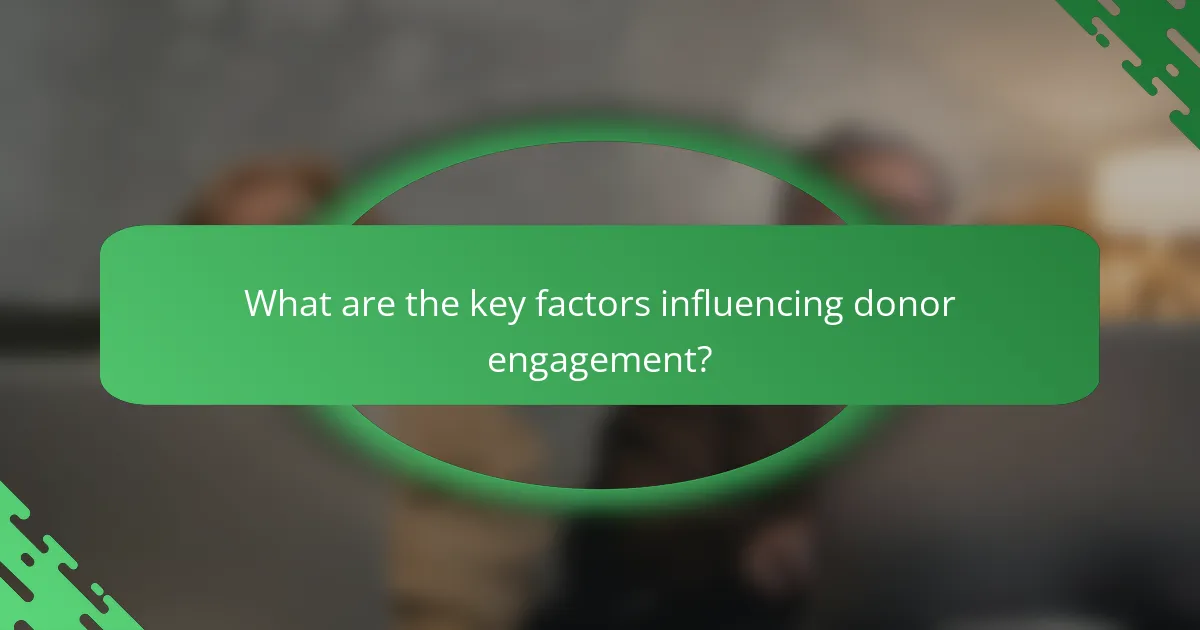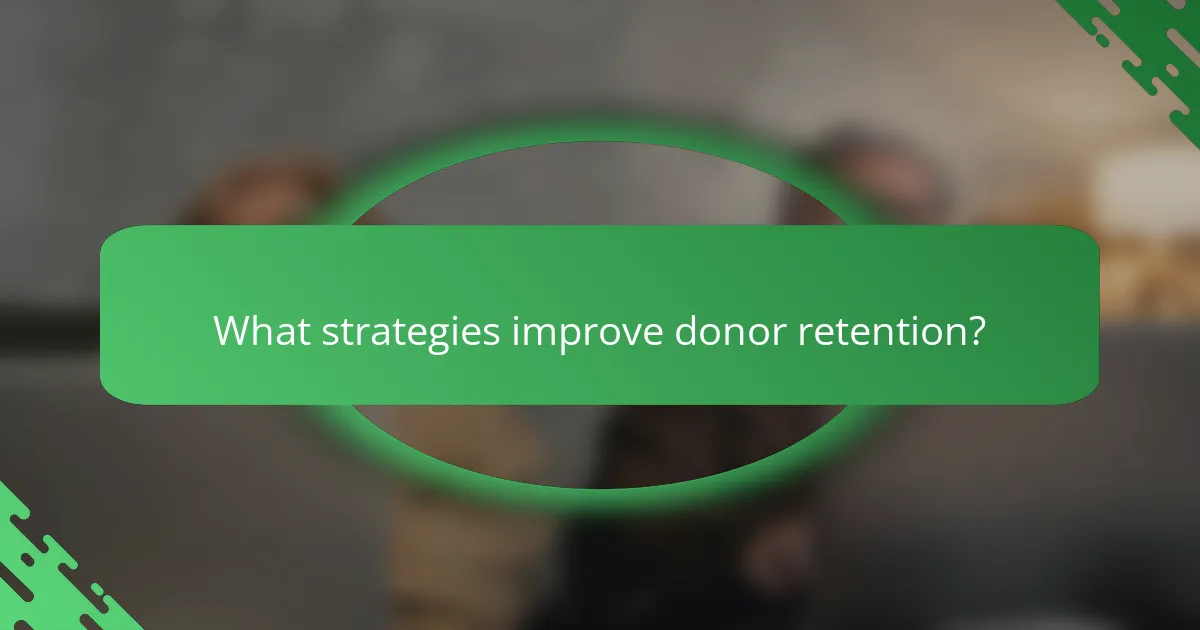Donor engagement is crucial for organizations seeking to cultivate lasting relationships and increase contributions. By focusing on personalized communication, trust, and emotional connections, organizations can enhance loyalty and support. Understanding key success factors and measuring engagement through various metrics allows for a more effective approach to building and maintaining donor relationships.

How to enhance donor engagement in the US?
Enhancing donor engagement in the US involves building strong relationships through personalized communication, recognition, and meaningful interactions. By employing effective strategies, organizations can foster loyalty and increase contributions over time.
Utilize personalized communication
Personalized communication is crucial for engaging donors effectively. Tailoring messages to individual preferences and past contributions can significantly enhance their connection to your cause. Use their names, acknowledge their previous support, and share updates that resonate with their interests.
Consider segmenting your donor list based on demographics or giving history to create targeted campaigns. This approach can lead to higher response rates and deeper engagement.
Implement donor recognition programs
Donor recognition programs are essential for showing appreciation and encouraging ongoing support. Acknowledging contributions through public recognition, such as donor walls or newsletters, can make supporters feel valued and connected to your mission.
Consider offering tiered recognition levels that provide different benefits, such as exclusive updates or invitations to special events. This can motivate donors to increase their giving to reach higher recognition tiers.
Leverage social media platforms
Social media platforms are powerful tools for enhancing donor engagement. They allow organizations to share stories, updates, and impact in real-time, creating a sense of community among supporters. Regularly posting engaging content can keep your audience informed and involved.
Utilize features like live videos, polls, and interactive posts to encourage participation. Engaging with donors through comments and messages can also strengthen relationships and encourage further support.
Host engaging events
Hosting engaging events is an effective way to connect with donors personally. These can range from casual meet-and-greets to formal fundraising galas, depending on your audience and resources. Events provide opportunities for donors to learn more about your organization and meet other supporters.
Ensure that events are interactive and meaningful, offering attendees a chance to see the impact of their contributions firsthand. Consider virtual events to reach a broader audience, especially in the current digital landscape.
Provide impact reports
Providing impact reports is vital for demonstrating the effectiveness of donor contributions. These reports should clearly outline how funds are used and the tangible outcomes achieved. Transparency builds trust and encourages continued support.
Consider using visuals, such as charts and infographics, to present data in an easily digestible format. Regularly sharing these reports can keep donors informed and engaged with your mission, reinforcing their commitment to your cause.

What are the key factors influencing donor engagement?
Key factors influencing donor engagement include trust and transparency, emotional connection to the cause, and effective storytelling. Understanding these elements can significantly enhance how organizations connect with their donors and encourage ongoing support.
Trust and transparency
Trust and transparency are foundational to donor engagement. Donors want to know that their contributions are being used effectively and ethically. Organizations should provide clear information about how funds are allocated and the impact of donations.
Regular updates and open communication can help build trust. For instance, sharing financial reports or success stories can reassure donors that their money is making a difference. Avoiding hidden fees and being upfront about operational costs also fosters a sense of transparency.
Emotional connection to the cause
Creating an emotional connection to the cause is crucial for deepening donor engagement. When donors feel personally invested in a mission, they are more likely to contribute and remain loyal. Organizations can achieve this by sharing relatable stories that highlight the human impact of their work.
Utilizing testimonials from beneficiaries or showcasing real-life scenarios can evoke empathy and inspire action. Engaging donors through personalized communication, such as thank-you notes or updates tailored to their interests, can further strengthen this emotional bond.
Effective storytelling
Effective storytelling is a powerful tool in engaging donors. A compelling narrative can illustrate the significance of a cause and the difference donations can make. Organizations should focus on crafting stories that are authentic, relatable, and resonate with their audience.
Using various formats, such as videos, blogs, or social media posts, can enhance storytelling efforts. Highlighting specific projects or individuals who have benefited from donations can create a vivid picture of impact. Additionally, incorporating visuals can make stories more engaging and memorable.

How to measure donor engagement success?
Measuring donor engagement success involves assessing various metrics that reflect how well donors connect with your organization. Key indicators include retention rates, donation frequency, and feedback from donors, which together provide a comprehensive view of engagement levels.
Track donor retention rates
Donor retention rates indicate how many donors continue to support your organization over time. A high retention rate, typically above 40%, suggests effective engagement strategies, while lower rates may signal issues that need addressing.
To track retention, compare the number of repeat donors in a given year to the total number of donors from the previous year. Regularly analyzing this data helps identify trends and areas for improvement.
Analyze donation frequency
Donation frequency measures how often donors contribute within a specific timeframe. Understanding this metric can help you tailor your outreach and engagement efforts to encourage more regular giving.
Consider segmenting donors based on their giving patterns, such as monthly, quarterly, or annual donations. This segmentation allows for targeted communication strategies that resonate with different donor types, enhancing overall engagement.
Evaluate feedback and surveys
Gathering feedback through surveys is essential for understanding donor satisfaction and engagement. Surveys can provide insights into donor motivations, preferences, and areas for improvement within your organization.
Implement regular surveys post-donation or during donor appreciation events. Aim for a response rate of at least 20% to ensure your findings are representative. Use this feedback to adjust your strategies and enhance donor relationships.

What strategies improve donor retention?
Effective donor retention strategies focus on building strong relationships and enhancing the donor experience. By implementing regular communication, personalizing interactions, and offering incentives, organizations can significantly increase the likelihood of repeat donations.
Regular communication updates
Consistent communication is vital for keeping donors engaged and informed. Regular updates about the impact of their contributions, upcoming events, and organizational news help maintain a connection and foster loyalty.
Consider using various channels such as newsletters, social media, and personalized emails to reach donors. Aim for a balanced frequency—monthly updates are often effective without overwhelming supporters.
Tailored donor experiences
Creating tailored experiences for donors enhances their connection to the cause. Personalization can include recognizing milestones, such as anniversaries of their first donation, and offering exclusive content or events based on their interests.
Utilize donor data to segment your audience and customize communications. For example, a donor who supports education initiatives may appreciate updates specifically related to that program, making them feel valued and understood.
Incentives for recurring donations
Offering incentives can motivate donors to commit to recurring donations. These incentives might include recognition in publications, exclusive access to events, or small tokens of appreciation, such as branded merchandise.
Ensure that the incentives align with your organization’s mission and values. For instance, a nonprofit focused on environmental conservation could offer eco-friendly gifts as a thank-you for recurring contributions, reinforcing the donor’s commitment to the cause.

How to create a donor engagement plan?
Creating a donor engagement plan involves outlining strategies to connect with and retain donors effectively. A well-structured plan focuses on understanding donor motivations, setting clear objectives, and utilizing various communication channels.
Define target audience
Identifying your target audience is crucial for effective donor engagement. Consider demographics such as age, income level, and interests, as these factors influence giving behavior. For instance, younger donors may prefer digital communication, while older donors might appreciate traditional methods.
Segment your audience into groups based on shared characteristics. This allows for tailored messaging that resonates with each segment, increasing the likelihood of engagement and support.
Set measurable goals
Establishing measurable goals helps track the effectiveness of your donor engagement efforts. Aim for specific targets, such as increasing donor retention rates by a certain percentage or raising a specific amount of funds within a defined timeframe.
Use the SMART criteria—Specific, Measurable, Achievable, Relevant, Time-bound—to formulate your goals. For example, instead of a vague goal like “increase donations,” specify “raise $50,000 in the next quarter from new donors.” This clarity aids in evaluating success and making necessary adjustments.
Develop a multi-channel approach
A multi-channel approach ensures that you reach donors through various platforms, enhancing engagement opportunities. Utilize email, social media, direct mail, and events to connect with donors where they are most active.
Consider the strengths of each channel. For example, social media can be effective for storytelling and sharing updates, while email can be used for personalized appeals. Regularly assess which channels yield the best results and adjust your strategy accordingly.
